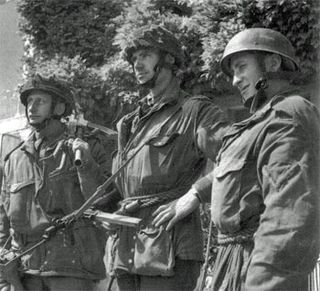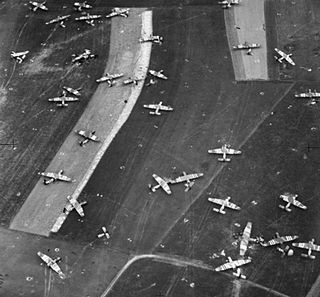This is a list of British Brigades in the Second World War. It is intended as a central place to access resources about formations of that size that served in the British Army during the Second World War.
This is a list of British Brigades in the Second World War. It is intended as a central place to access resources about formations of that size that served in the British Army during the Second World War.

The 1st Airborne Division was an airborne infantry division of the British Army during the Second World War. The division was formed in late 1941 during World War II, after the British Prime Minister, Winston Churchill, demanded an airborne force, and was initially under command of Major-General Frederick A. M. Browning. The division was one of two airborne divisions raised by the British Army during the war, with the other being the 6th Airborne Division, created in May 1943, using former units of the 1st Airborne Division.

The 6th Airborne Division was an airborne infantry division of the British Army during the Second World War. Despite its name, the 6th was actually the second of two airborne divisions raised by the British Army during the war, the other being the 1st Airborne Division. The 6th Airborne Division was formed in the Second World War, in mid-1943, and was commanded by Major-General Richard N. Gale. The division consisted of the 3rd and 5th Parachute Brigades along with the 6th Airlanding Brigade and supporting units.
This is the complete order of battle of Allied and German forces involved during Operation Market Garden.
The Liverpool Welsh, under various guises, was a unit of Britain's Volunteer Force and Territorial Army (TA) associated with the King's Liverpool Regiment. It served as a tank regiment in the Western Desert and Italian Campaigns in the Second World War, as a security force during the Greek Civil War, and as a heavy anti-aircraft artillery regiment postwar.

The 22nd Armoured Brigade was an armoured brigade of the British Army that saw service during and after World War II. The brigade was formed on the outbreak of war on 3 September 1939 from Yeomanry mechanised cavalry regiments of the Territorial Army (TA). It saw a considerable amount of action during the war, beginning with the Western Desert Campaign where it was engaged in Operation Crusader and at the Battles of Gazala, Mersa Matruh, First Alamein and Alam el Halfa. It then joined the 7th Armoured Division for the Second Battle of El Alamein. It remained part of 7th Armoured for the rest of the war, including the campaigns in Tunisia, Italy and North West Europe. It continued in the postwar TA until 1956. The brigade's identity was re-established in the Regular Army between 1981 and 1993.

The 5th Parachute Brigade was an airborne forces formation of brigade strength, raised by the British Army during the Second World War. Created during 1943, the brigade was assigned to the 6th Airborne Division, serving alongside the 3rd Parachute Brigade and the 6th Airlanding Brigade.

The 1st Parachute Brigade was an airborne forces brigade formed by the British Army during the Second World War. As its name indicates, the unit was the first parachute infantry brigade formation in the British Army.

The 2nd Parachute Brigade was an airborne forces brigade formed by the British Army during the Second World War.

The 1st Airlanding Brigade was an airborne infantry brigade of the British Army during the Second World War and the only glider infantry formation assigned to the 1st Airborne Division, serving alongside the 1st and 4th Parachute Brigades.
The Second Battle of El Alamein order of battle is a listing of the significant formations that were involved in the Second Battle of El Alamein during the Western Desert Campaign of the Second World War, 23 October – 4 November 1942.

The 6th Airlanding Brigade was an airborne infantry brigade of the British Army during the Second World War. Created during May 1943, the brigade was composed of three glider infantry battalions and supporting units, and was assigned to the 6th Airborne Division, alongside the 3rd and 5th Parachute Brigades.
This is the order of battle for the ground forces involved in Operation Crusader, a World War II battle between the British Commonwealth and the European Axis Powers of Germany and Italy in North Africa between 18 November – 30 December 1941.

Operation Mallard was the codename for an airborne forces operation, which was conducted by the British Army on 6 June 1944, as part of the Normandy landings during the Second World War.
This article supplements the 7th Armoured Division article by providing order of battle information for the division through various periods of the Second World War as the organization of an armoured division was changed by the War Office. Due to the experience gained in the Middle East these changes were sometimes present in the armoured divisions there before the War Office mandated organization. Parallel changes were made in the organization in the armoured brigades. The Division frequently did not match any organization scheme due to the lack of units in the Middle East.

The Allied invasion of Italy, a phase of the Mediterranean Theater of World War II, took place on 3 September at Reggio di Calabria, and on 9 September 1943 at Taranto and Salerno. Allied naval forces landed American and Commonwealth troops on the beaches of southern Italy where they faced resistance from Axis forces.
In September 1939, the British Army was in process of expanded their anti-aircraft and mobile assets. Among these new changes was the formation of Anti-Aircraft Command which was formed on 1 April 1939, and the 1st Armoured Division formed in 1937. The list below will include the British Army units, colonial units, and those units which were in the process of formation.

The 6th Airborne Division order of battle lists only those units assigned to the division; units attached only for short periods of time are not included.
The 93rd Light Anti-Aircraft Regiment was an air defence unit of the British Army's Royal Artillery (RA) during World War II. Elements of the regiment landed with special equipment on D-Day, and served in the Normandy campaign. The regiment went on to defend Belgian cities against V-1 flying bombs and participated in the assault crossing of the Rhine.

The 1st Devonshire Artillery Volunteers and its successor units served in the British Army's Reserve Forces from 1859 to 1961. During World War I it carried out garrison duty in British India but went on to see active service in the Third Anglo-Afghan War. Converting to an air defence role before World War II its units participated in the Norwegian campaign and the Dunkirk evacuation, the Battle of Britain and then the campaigns in North Africa, Italy, and Burma
Following the end of hostilities, by 1946 most territorial artillery regiments had been either disbanded or placed in suspended animation. On 1 January 1947 many of these battalions/regiments were reconstituted and many new regiments were formed as part of the reformed and re-organised Territorial Army (TA). All units will be shown as they were on 1 January 1947, and not those who joined later that year, although notes on that unit's changes during that year will be shown.